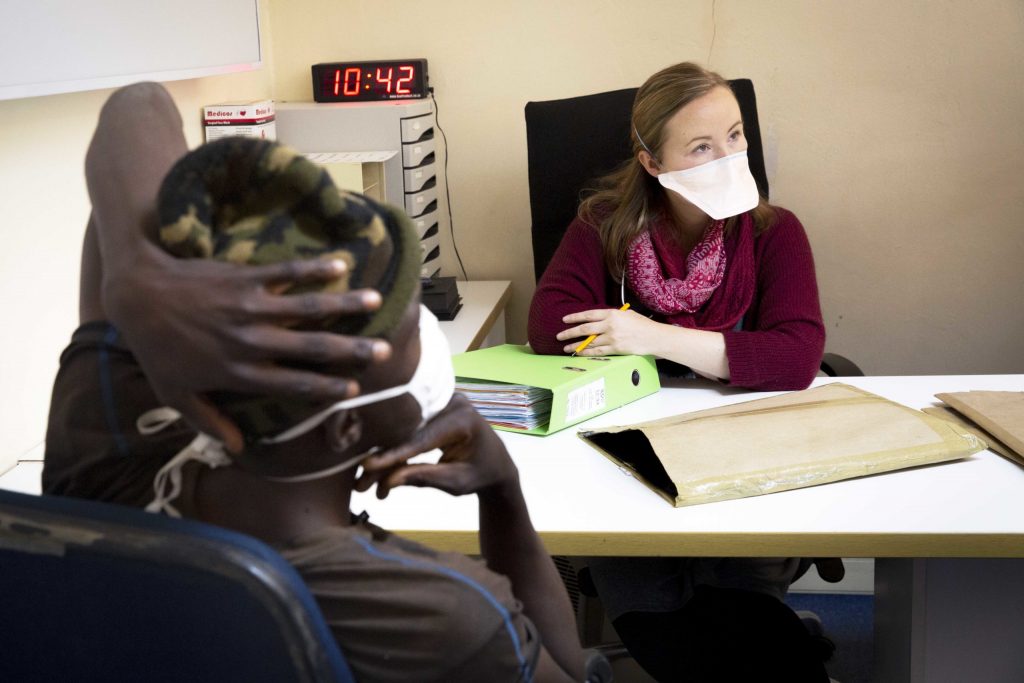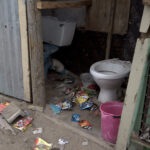- Researchers struggle to understand how teenagers experience tuberculosis (TB) treatment, and they haven’t done enough to ask, experts at last week’s 7th South African TB Conference, argued.
- It’s a blind spot that leaves adolescents in the lurch at a time when changes in their immune systems and social lives also make this group more likely to become sick with TB.
- TB, which is both preventable and treatable, was the leading cause of death for teens (ages 10 to 19) in South Africa between 2008 and 2018.
Fourteen months, seven facilities (in the Eastern Cape, Western Cape and KwaZulu-Natal), two types of treatment (hundreds of pills), six months in hospital and two missed years of school.
That’s what it took for Akona Tshwete*, 13, to recover from tuberculosis (TB), according to his doctor, Juli Switala. Switala is a paediatrician at the health organisation, The Aurum Institute, and was speaking at last week’s 7th South African TB Conference in Durban.
The situation could have been avoided, says Switala — if Tshwete had access to a treatment programme geared towards his and other teens’ specific needs.
TB treatment can be tough to take. For teens of up to 16 years of age, drug courses are between four and six months, depending on the severity of their TB, according to World Health Organisation guidelines issued in March.
South Africa’s national plan to treat TB, aims to get 100% of people diagnosed with the disease onto treatment by the end of this year. The document also outlines plans to make sure 90% of those who have a form of TB that responds to regular medicines actually complete a course of treatment by 2022, and the same goes for 75% of those who have drug-resistant TB.
But adolescents (people between 10 years and 19 years) pose a particular challenge to TB projects.

In short: grown-ups are terrible at finding out how teenagers experience TB, and haven’t done enough to ask them, Graeme Hoddinott, a senior researcher at Stellenbosch University’s Desmond Tutu TB Centre, says.
Puberty, which strikes between the ages of 8 and 14, makes adolescents more likely to fall ill with TB. Researchers think this may be the case because teens lose the protection of their primary school immune system (which is good at controlling infection) in exchange for something closer to adult immunity (which is not as good at keeping disease at bay).
During puberty, Hoddinott says, teens also undergo hormonal changes, which researchers think may increase the likelihood of TB infection progressing to the actual disease.
Moreover, teenagers spend a great deal of their time in classrooms, where the risk of getting infected with TB can be as high as in clinics, according to a study published in the The American Journal of Respiratory and Critical Care Medicine in February. The research analysed the air in 72 classrooms in two South African schools and compared the results to that of the air in public health clinics. They found the risk of infection in clinics and classrooms was the same.
TB also spreads through the air, so once adolescents are infected, their budding social lives mean they have more opportunities to pass the germ onto their peers. Research, for instance, shows that teens hang out in groups where they gather in close proximity to each other (also called congregate settings) more often than adults in their thirties.
Does our health system look after teens?
The way that health services in South Africa are set up isn’t working for adolescents.
“We’re serving them very badly,” says Hoddinott.
Switala explains: “Teens no longer need child services, but they’re not quite adults either, so they often fall through the cracks.”
Data supports Switala’s statement. A 2019 study, for example, shows adolescents were more likely than youth (people between 20 and 24) and adults (people of 25 and older) to stop taking their TB pills before the end of their regimen. Several other studies have also found that the risk of teens not taking their treatment continues, and often increases, when they become young adults (people between 20-24).
As a result, many young people still die of this treatable disease — a fate that befell more than 18 000 adolescents (ages 10 to 19) and children (those below 10 years of age) in the country between 2004 and 2016.
TB was the leading cause of death for adolescents living in South Africa in the decade leading up to 2018, shows Statistics South Africa data.
What makes teenagers happy?
Researchers say TB treatment programmes need to be based on compassion and an understanding of what teens are going through during adolescence — rather than judging them for it.
Teenagers need five things to be happy — good health, a feeling of connectedness to other people, a safe home environment, education and the freedom to make decisions about their lives, a 2021 Journal of Adolescent Health article argues. When these boxes are all ticked, the research shows, adolescents are better equipped for adult life.
But TB interferes with this process, found a study published in Pathogens in 2021.
How? The treatment needed disrupts their routines and the disease exposes adolescents to severe stigma.
People on treatment for drug resistant TB, have to, for example, isolate themselves at home or in hospital until doctors have established that they’re no longer infectious. But this can interrupt teens’ daily routines such as school. Because of the stigma accompanying the disease, TB treatment may also cause a rift in teens’ relationships with their friends, family or romantic partners.
“[The children in the neighbourhood] call me names and they hit me and stuff like that. [They say] ‘TB thing, just go away’. They think I’m going to infect them,” a 12-year old in Cape Town told researchers.
In the long term, people who survive TB may have permanent lung damage from the infection (called “post-TB lung disease”). The condition makes it harder for people to work, study or do the kind of exercise they may want to do.
The long-term impact of the disease on adolescents’ lungs is mostly unstudied, but the Pathogen authors argue that the fact that teens often drop out of treatment doesn’t bode well for the lasting health of their lungs.
Switala warns: “Hospitalisation should be the very last resort doctors choose when they’re treating teenagers.”
Why clinical research doesn’t go far enough
The true emotional toll of TB treatment was likely hidden from researchers because they weren’t asking teens questions in the right way, found research published in The International Journal of Tuberculosis and Lung Disease.
When doctors and nurses interviewed a small group of adolescents about whether they’d experienced a list of ten adverse events of the treatment they were getting, almost all of them (eight) said that they didn’t have any of the symptoms.
Adverse events are the negative effects people may experience when they take a medicine.
From interviews with clinicians, it seemed that the young people in the study were doing relatively well.
But then, the doctors left the room and teens were asked to draw what they were going through on body maps (guided by a counsellor).
For that scenario, a much darker picture emerged — one of anger, loneliness and intense discomfort.
Tiffany, 13, said she was scared, because it felt as if the needles were being injected “into her bones”. Another teen study participant, Luke, wrote “hurts” next to a heart he’d drawn on his chest. And Candice, 14, noted “I HATE TB” on her body map.
Some drawings even revealed thoughts of suicide: “want to die” was scribbled on one adolescent’s card.
South Africa has introduced a gentler multi-drug resistant TB treatment called bedaquilline (the drug course is shorter and has fewer side effects) for people older than 12 since Hoddinott and his colleagues collected this data, and many researchers now ask child participants about pain.
Still, Hoddinott argues that the benefits of new treatments could be reduced if researchers don’t understand how teenagers are experiencing them.
What can clinics do to help teenagers?
When it comes to TB, South Africa’s clinics must be able to accommodate teenagers’ needs, Switala says — and that means understanding how adolescents see the world.
Similar programmes already exist for HIV, a virus with which adolescent girls and young women in Africa are infected disproportionately. Such HIV projects, for instance, the Desmond Tutu Health Foundation’s “Tutu Teen Trucks” park at places where adolescents hang out after school, such as sports fields and outside shopping centres, and play music for those waiting in line. The mobile units are colourful and have a social media presence that teens can follow, and they can get a WhatsApp when the unit is visiting their area.
The staff that run the truck are specialists in adolescent healthcare.
But setting up separate TB clinics for teenagers might fuel stigma, Hoddinott warns. There are, however, changes facilities can make easily to make TB clinics more teen friendly.
For one, health workers shouldn’t book appointments for teens during school holidays, exam periods or after school, says Switala — short appointments during school time works better. Adolescents should also not be forced to miss important sports or social events to come into the clinic (because a clinic visit is likely to come second). Moreover, flexible appointment times would accommodate teenagers who live between multiple households, Switala says.
Teens also don’t want to be known as the “TB kid” at school.
They often worry that if they’re seen at public health clinics where TB patients frequently use a separate entrance, people will know that they’re ill and then stigmatise them and treat them differently, research shows.
Hoddinott says fast-lane pickups at clinics for teens to collect their treatment, so they don’t spend long periods in queues and miss too much school as a result, could increase teens’ uptake of treatment.
Helping school kids with TB to share their experience with their peers could also reduce stigmatisation and make other learners more likely to go for TB screening and get treatment if they get diagnosed with the disease.
Switala says TB treatment plans will also only be successful if they acknowledge that “even the most reliable teenagers are still teenagers”. One of her most conscientious young patients stopped taking her TB pills once she returned home from hospital because she believed that people knew that she was ill and that she “deserved to die”.
The power of peer pressure among teenagers should not be underestimated, argues Switala — it can be used in TB treatment too. “Consider setting up WhatsApp support groups for teenagers or team them up with a buddy on similar treatment.”
But choosing the right supporter for adolescents on TB treatment isn’t as straightforward as picking their parent or guardian. Switala says she learned this with other diseases requiring complex treatment as well.
One of her Cape Town patients with diabetes is a good example of this. The young girl has limited intellectual abilities, but has to get insulin injections every day. Her brother is a gang member and he’s so dedicated to his sister’s treatment that even when he’s been in prison, the gang as a whole still made sure the girl got to her clinic appointments.
Switala explains: “Those gang members were much better allies for her than her parents ever were.”
*Akona Tshwete is a pseudonym.
Joan van Dyk was a health journalist, senior health journalist and news editor at Bhekisisa between 2017 and 2023.







